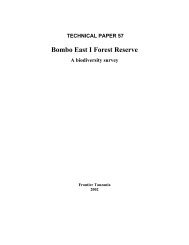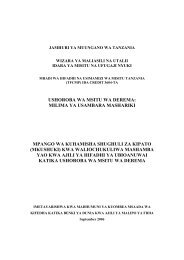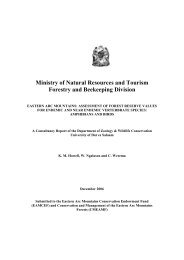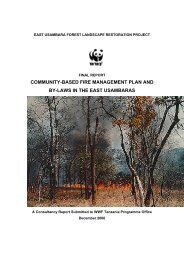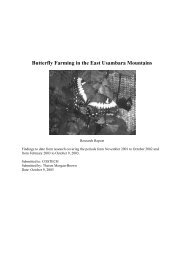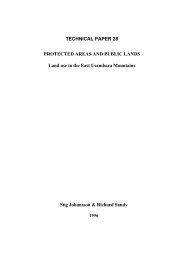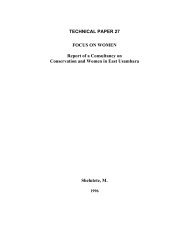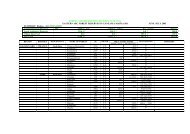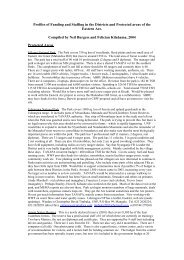Mgambo Forest Reserve: A biodiversity survey. - Eastern Arc ...
Mgambo Forest Reserve: A biodiversity survey. - Eastern Arc ...
Mgambo Forest Reserve: A biodiversity survey. - Eastern Arc ...
Create successful ePaper yourself
Turn your PDF publications into a flip-book with our unique Google optimized e-Paper software.
<strong>Mgambo</strong> <strong>Forest</strong> <strong>Reserve</strong><br />
An additional one near endemic reptile species was recorded through observation, Lygodactylus<br />
lutecpicturatus (Yellow-headed dwarf gecko).<br />
Additionally, two species of Chameleon were observed just outside of the forest reserve,<br />
Chameleo dilepsis (Flap-necked chameleon), a widespread forest dwelling species, and Chameleo<br />
melleri (Giant one-horned chameleon), mostly distributed along the coast in well-wooded<br />
savannah and woodland.<br />
Many of the species found in <strong>Mgambo</strong> predominantly range in the <strong>Eastern</strong> coastal forests with<br />
some patchy distribution in other more central parts of east and central Africa. Therefore, although<br />
they cannot be categorised as ‘near endemic’ based on the definition given in this report, they are<br />
of limited distribution. For example, Dendroaspis angusticeps (Green mamba, see Figure 22),<br />
Heliobolus spekii spekii (Speke’s sand lizard), Holaspis guentheri laevis (Blue-tailed lizard) and<br />
Cnemaspis africana (Usambara forest gecko).<br />
Both the forest dependent reptiles were captured in good quality patchily distributed riverine<br />
forest. The presence or absence of Holaspis guentheri laevis may be a good future indicator of the<br />
levels of deforestation to the remaining areas of lowland forest.<br />
Of interest was the capture of 5 junevile Scaphiophus albopunctatus (Hook-nosed snake) at<br />
trapsite 4, an area of scrub forest. This species is not currently on the East Usambara database<br />
(available from EUCAMP). The East African population of this genus seems to be isolated<br />
(Spawls et al 2002). Also interesting was the sighting of an adult Varanus niloticus (Nile monitor<br />
lizard).<br />
Most of the reptiles species captured and observed seemed to be indicative of the disturbance seen<br />
throughout the reserve, reflecting a tendency for dry habitat, open woodland / savannah species to<br />
dominate, such as Latastia longicaudata (Southern long-tailed lizard), Pachydactylus sp. (Thicktoed<br />
gecko) and Natriciteres olivecea (Olive marsh snake). Even the near endemic Rhampholeon<br />
k. kerstenii (Kenyan pygmy chameloen) prefers a dry habitat.<br />
Figure 22 Green mamba (Dendroaspis angusticeps), found in riverine forest.<br />
This individual was approximately 2m in length.<br />
East Usambara Conservation Area Management Programme Technical Paper 59<br />
59



